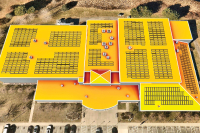The Naturalist's Corner
Winter solstice
Star
Shining
Close and dear
Warming blue oceans
Related Items
Warming the brown earth
Catalyst in primordial ooze
Life affirming warmth and light
Crawling orange across the earth
Scattering darkness chasing shadows
Climbing high and round in golden glory
Climbing high and round in glorious warmth
Coaxing green shoots to reach ever skyward
Dancing on wave and ripple and slick pond tops
Casting shadows beneath trees and over meadows
Only to slip again and begin sliding down and westward
To disappear orange with cold black night nipping your heels
No one knows when or how or why this marvelous race began
No one knows when or how or why this marvelous race will end
But we know tomorrow this shining star will speed across the sky
Day will be the shortest day and the night the longest one we’ll see
Winter solstice
Winter’s night
Cold lingering
Winter’s night
It doesn’t last
Close and dear
A star appears
Tomorrow is the winter solstice, below is part of an article I wrote for the Dec. 20. 2000, issue of Smoky Mountain News. Enjoy and have a happy solstice.
For ancient peoples living in northern latitudes winter was a very trying time. The sun stayed low in the sky and disappeared quickly, days grew shorter and nights grew longer and temperatures fell. They had to live on stored provisions or what animals they might kill. Some feared the sun would disappear completely leaving the world in cold darkness.
After time the people would notice the sun once again growing higher in the sky and the days becoming longer. This was cause for great celebration. All aboriginal peoples in the northern latitudes celebrated the winter solstice. It was the rebirth of the sun, the rekindling of the fire of life.
Ancient Greeks celebrated “Lenaed” while Romans celebrated “Saturnalia.” The Hopi Indians have a 20-day celebration called “Soyal” during which they give aid and direction to the sun as it returns and gives strength to budding life.
Although aboriginal people had no elaborate instruments to measure the solstice, there are stone structures and monuments all around the world that appear to be tied to the solstice. Some of the oldest are in Ireland and Scotland.
In County Meath, in eastern Ireland, is a cairn that dates back to 3,300 BC. It covers nearly an acre and has a passageway 60 feet long. Above the entranceway is a small stone window. At sunrise on the winter solstice — and at no other time — sunlight penetrates all the way back to the back wall of the cairn.
In Orkneys, Scotland, there is another ancient cairn, Maes Howe, which dates back to 2,500 BC. This cairn is also designed to let sunlight in on the winter solstice. This structure was known to have contained treasures. A runic inscription probably carved in the 12th century AD by raiding Vikings reads, in part, “A long time ago was a great treasure hidden here. Lucky will be he who can find the great fortune. Hakon single-handed bore treasure from this howe.”
In Vermont, there is a natural amphitheater about 20 acres in size. It was named “Calendar One” by its discoverer. There is a stone enclosure in the center. From this enclosure, one can see a number of vertical rocks and other natural features, which create the rim of the amphitheater. During the winter and summer solstices and the spring and fall equinoxes, the sun rises and sets on certain peaks and notches in the rim.
The exact significance of these cairns and other monuments will, probably, never be known. There is little doubt that they were, and still are, recording and acknowledging the solstice. It cannot go unnoticed.
(Don Hendershot is a writer and naturalist who lives in Waynesville. He can be reached at This email address is being protected from spambots. You need JavaScript enabled to view it.)









